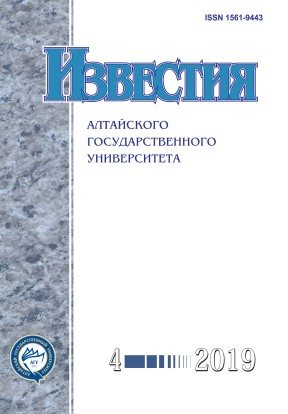Структура и свойства материалов на основе сплавов и тонких пленок ниобия с оловом
УДК 546.8:661.88
DOI:
https://doi.org/10.14258/izvasu(2019)4-06Ключевые слова:
сплавы, тонкие пленки, интерметаллические соединения, фаза, поверхностьАннотация
Методами дифференциального термического (ДТА), рентгенофазового (РФА), энергодисперсионного анализа исследованы структура и свойства материалов на основе сплавов и тонких пленок ниобия с оловом. Условия синтеза и температурные интервалы устойчивости к окислению определяли из данных ДТА. Исследование устойчивости пленок на воздухе проводили, выдерживая их при комнатной температуре 1-3 месяца и при нагревании до 100 и 250 °С в течение 2 часов. Сплавы получали непосредственным сплавлением компонентов при 800 °С с последующим размалыванием, прессованием и спеканием при 500 °С в течение 100 часов. Фазовый состав сплавов устанавливали методом РФА. Рентгенофазовый анализ тонких пленок показал, что на поверхности подложки при осаждении из газовой фазы обычно осаждаются термодинамически наиболее устойчивые соединения в системе. Исследование рельефа поверхности с помощью атомно-силового микроскопа показало, что поверхность пленок остается неизменной при выдержке при нормальной температуре до 3 месяцев. Определенные четырехзондовым методом величины сопротивления показывают, что сопротивление пленок увеличилось примерно на 20-30 % по сравнению с компактными веществами.
Скачивания
Библиографические ссылки
Taylor D.M.J., Keys S.A., Hampshire D.P E-J. Characteristics and n-Values ofa Niobium-Tin Superconducting Wire as a Function of Magnetic Field, Temperature and Strain // Physica C. 2002. 372-376 (3).
Awaji S., Watanabe K., Nishijima G., Katagiri K., Miyosh, K., Meguro S.-i. Enhancement of Critical Current Densities by the Prebending Strain at Room Temperature for Nb3Sn Wires // Japan. J. Appl. Phys. 2003. 42 (10A). L. 1142- 1144.
Patancar S.N., Froes F.H. Formation of Nb3Sn Using Mechanically Alloyed Nb-Sn Powder // Solid State Sci. 2004. 6 (8).
Mannan S.H., Clode M.P, Dagher M. Study of Intermetallic Crystal Growth Between Nb and Molten 52In-48Sn Solder // J. Electron. Mater. 32 (2). 2005.
Vassilev G. Systematic of binary phase diagrams, formed by low-melting elements (Bi, Sn, Zn, In) and the metals of IV-th and V-th periods // J. Min. Metall. B Metall. 2005. 41 (1).
Okamoto H. Nb-Sn (Niobium-Tin). //J. Phase Equilibria 2003. 24 (4).
Scheuerlein C., Di Michiel M., Haibel A. On the formation of voids in internal tin Nb3Sn superconductors // Appl. Phys. Lett. 2007. 90 (13). 132510-132510-3.
Popova E.N., Sudareva S.V., Romanov E.P et al Effect of Alloying on the Structure of Bronze with Enhanced Tin Content // Phys. Met. Metallogr. 2007. 103 (2).
Pong I., Hopkins S., Fu X. et al. Micro structure development in Nb3Sn(Ti) internal tin superconducting wire // J. Mater. Sci. 2008. 43 (10).
Escudero R., Morales F., Bernes S. Specific heat studies of pure Nb3Sn single crystals at low temperature // J. Phys.: Condens. M3atter. 2009. 21 (32). 325701.
Aleksashin B.A., Soloninin A.V., Korolev A.V et al. Investigation into nanocrystalline Nb3Sn layers structure in multifilamentary superconductors of different geometry using NMR and magnetic susceptibility methods // Inorg. Mater.: Appl. Res., 2010. 1 (1).
Novosilova D.S., Abdyukhanov I.M., Vorob'eva A.E et al. Influence of diffusion annealing on residual resistivity of Nb3Sn-based chromium-plated strands obtained by a bronze process // Phys. Met. Metallogr. 2012. 113 (10).
Deambrosis S.M., Keppel G., Ramazzo V. et al. A15 superconductors: An alternative to niobium for RF cavities // Phys. C (Amsterdam) 441. 2006.
Соколовская Е.М., Гузей Л.С. Металлохимия. М., 1986.
Webb G.W., Fisk Z., Engelhardt J.J., Bader S.D. Apparent T2 dependense of the normal state resistivites and lattice heat capacites of high-Tc supercoductors // Phys. Rev. B: Solid state. 1977.
Guseva I.A., Seropegin Y.D., Sokolovskaya E.M. The properties of zirconium-doped Nb3Sn-Nb3Ge solid solutions // J. Less-common Metals. 1982. 87.
Загрузки
Опубликован
Выпуск
Раздел
Лицензия
Izvestiya of Altai State University is a golden publisher, as we allow self-archiving, but most importantly we are fully transparent about your rights.
Authors may present and discuss their findings ahead of publication: at biological or scientific conferences, on preprint servers, in public databases, and in blogs, wikis, tweets, and other informal communication channels.
Izvestiya of Altai State University allows authors to deposit manuscripts (currently under review or those for intended submission to Izvestiya of Altai State University) in non-commercial, pre-print servers such as ArXiv.
Authors who publish with this journal agree to the following terms:
- Authors retain copyright and grant the journal right of first publication with the work simultaneously licensed under a Creative Commons Attribution License (CC BY 4.0) that allows others to share the work with an acknowledgement of the work's authorship and initial publication in this journal.
- Authors are able to enter into separate, additional contractual arrangements for the non-exclusive distribution of the journal's published version of the work (e.g., post it to an institutional repository or publish it in a book), with an acknowledgement of its initial publication in this journal.
- Authors are permitted and encouraged to post their work online (e.g., in institutional repositories or on their website) prior to and during the submission process, as it can lead to productive exchanges, as well as earlier and greater citation of published work (See The Effect of Open Access).








